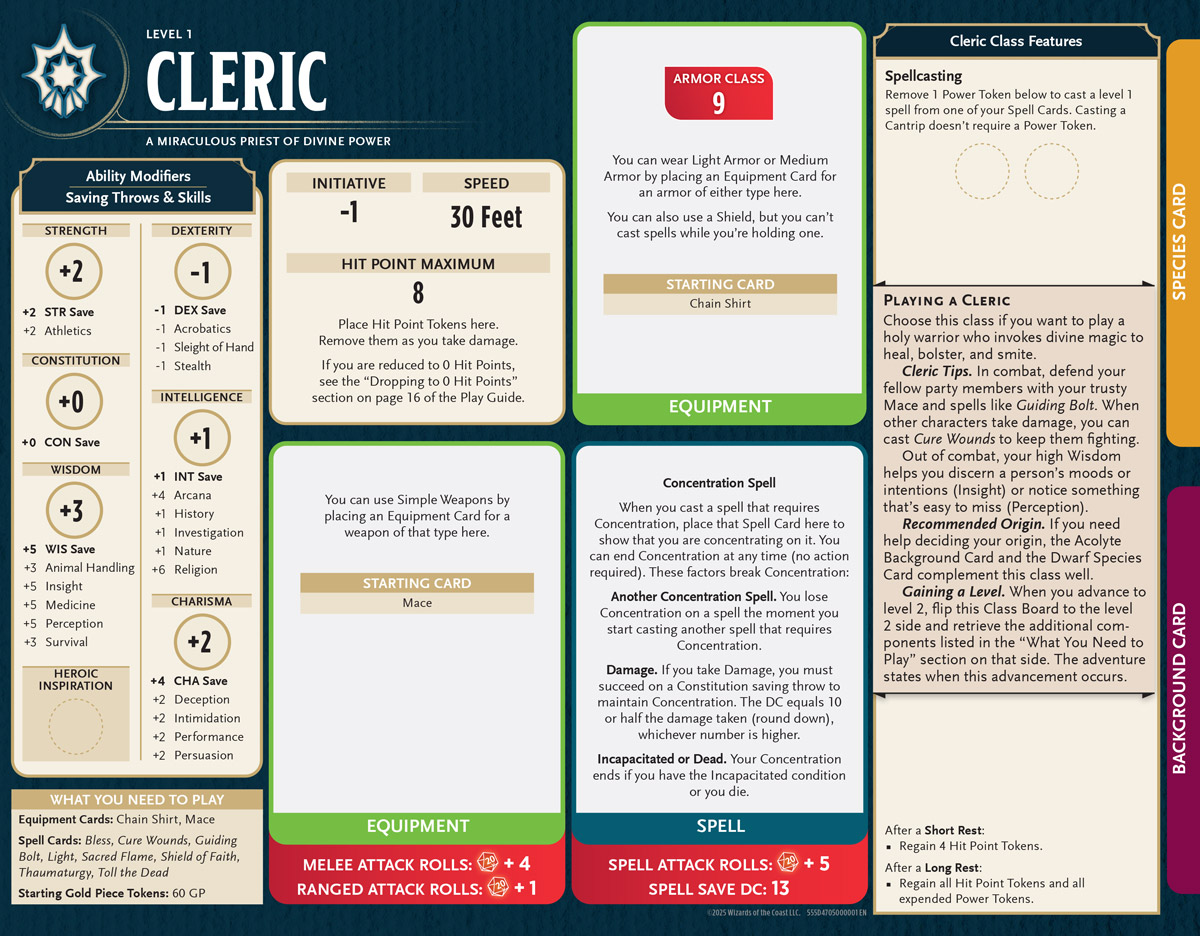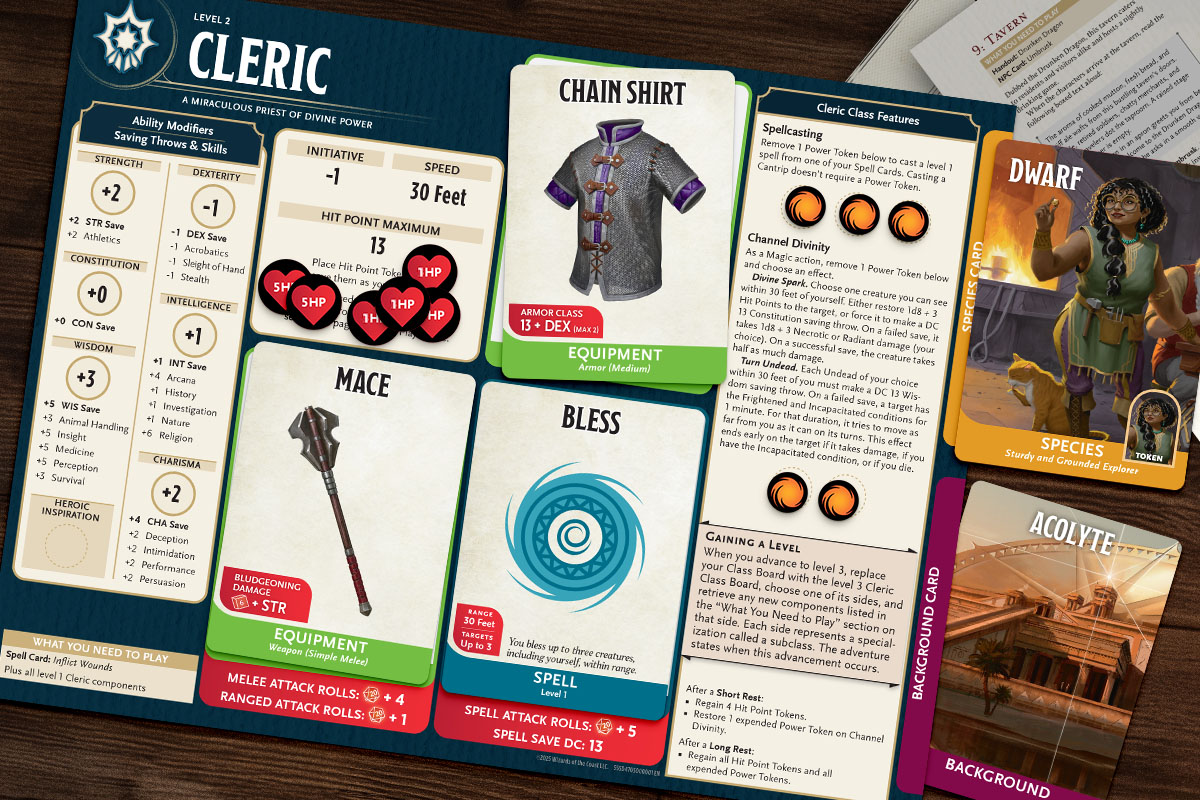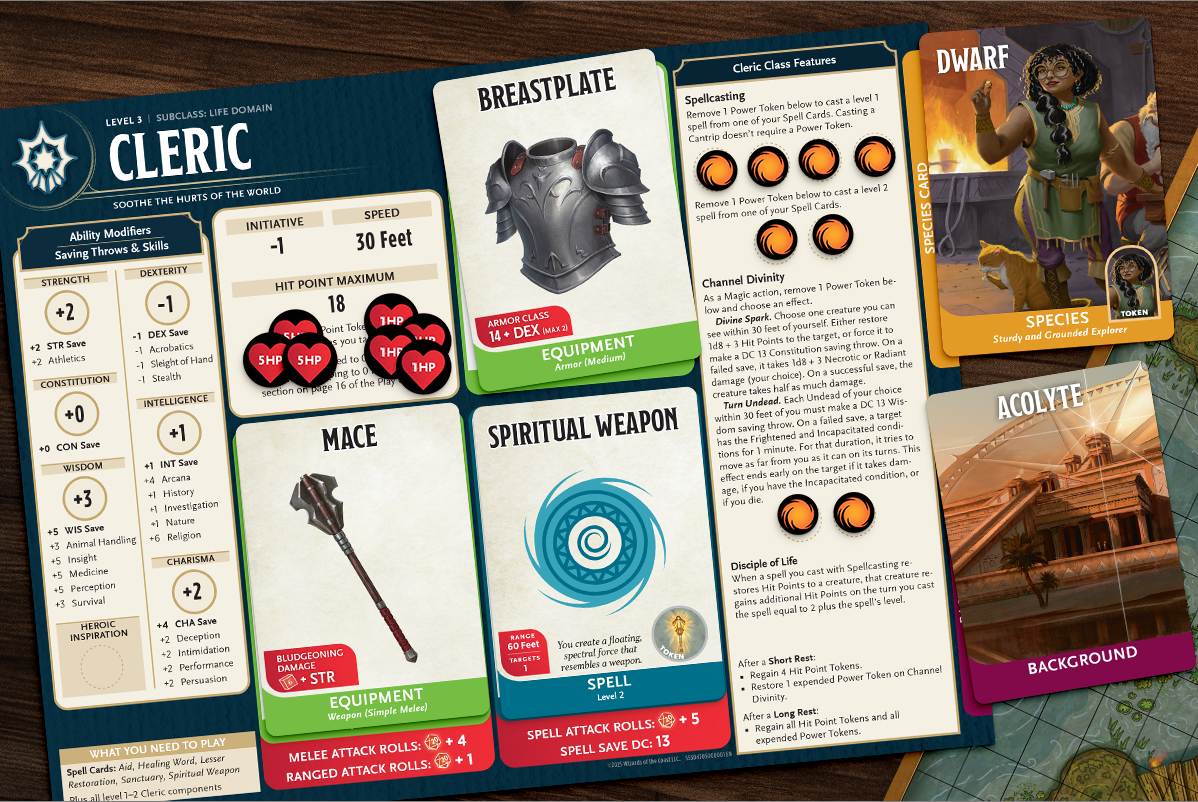When you open the Heroes of the Borderlands box, one of the first treasures you'll discover are the class boards. These are your gateway into the role of a hero, designed to combine the imagination of Dungeons & Dragons with the ease of use of a board game. Each board is a dashboard that clearly lays out everything you need to play, from your Armor Class to your spells and features, with card slots and token trackers that keep the game moving fast.
Let's explore how these boards make introducing new players to D&D smoother, faster, and more fun than ever before!
The Anatomy of a Class Board

Every class in Heroes of the Borderlands has its own board, but they share a similar layout so that new players can quickly find what matters. Let's break down the core sections:
Everything You Need to Get Rolling on Adventures
Each board is built so you can sit down, sort out a few cards, and start adventuring. The essential rules of your class are presented front and center, while the gear and gold you start with are listed in a tidy checklist.
- Ability Modifiers. The six core abilities—Strength, Dexterity, Constitution, Intelligence, Wisdom, and Charisma—dictate your character's strengths. Modifiers are pre-calculated and printed, so you can jump right into play with everything you need to make checks, saves, and attacks with zero prep.
- Saving Throws and Skills. These sections seamlessly include your proficiencies to highlight where your hero shines.
- What You Need to Play. This checklist shows which cards and tokens you'll need for your class. For example, the Cleric begins with a Chain Shirt, a Mace, a suite of staple spells like Bless and Cure Wounds, and 60 GP.
- Playing Your Class. You'll also receive guidance on both the fantasy of the class and the strategy behind it. This includes recommended origin cards to help streamline character creation as much as possible.
Combat and Class Features at a Glance
When it's time to draw steel or let spells fly, you won't need to go flipping through pages—everything you need to know about what your character can do is laid out in front of you.
- Initiative, Speed, and Hit Points. These trackers streamline combat. Tokens for Hit Points are a physical component, so losing tokens feels more like your character is fighting to stay standing.
- Attacking. Need to cast an offensive spell or swing your sword? Everything you need is prominently displayed alongside an icon for which dice you need to roll.
- Card Spaces. Clearly marked slots show where to place armor, origin, spell, and weapon cards. This keeps your table neat and helps you understand where your abilities are coming from and how to use them.
Bite-Sized Learning
Veteran D&D players will notice that these class boards slightly bend character creation and play rules to skirt around the more in-the-weeds details. This is done intentionally to help make onboarding as straightforward as possible.
For instance, you'll see that the section on Short Rest doesn't say anything about rolling Hit Point Dice; just that the character automatically receives 4 Hit Points after a Short Rest.
Similarly, the board doesn't mess around with describing components and weapon juggling to cast spells. It simply states, "You can also use a Shield, but you can't cast spells while you're holding one."
Growing with Your Hero
These boards evolve with your character. As you level up, discover new gear, and grow your abilities, your play surface changes in ways you can feel.
Level 2: A Burgeoning Hero

Each character's starting board is double-sided. When you level up to level 2, you flip the board over. The reverse side updates your Hit Points, adds new features, and expands your options without adding complexity. It's a smooth, tactile way to mark your growth.
Level 3: Specializing Your Role

At level 3, you swap your board for one tailored to your subclass choice. For the Cleric, you choose between the Life Domain and the Light Domain. The Life board emphasizes healing, durability, and protection, while the Light board unlocks radiant power and fiery spells that burn away the dark.
Every character receives new and unique powers at this milestone, and the boards reflect that choice clearly with new spells or subclass features printed right where you need them.
Designed for Play, Not Paperwork
These boards serve as an introduction to what used to be an intimidating character sheet with an easy-to-read play surface. Tokens, cards, and dedicated spaces all work together like a living rulebook and prepare players for the experience of a full character sheet when they're ready.
For new players, this means Heroes of the Borderlands can enable faster learning and more fun. For veterans, it means more friends and family members to play with, fewer interrupting rule lookups, and more time telling stories!

Mike Bernier is the founder of Arcane Eye, a site focused on providing useful tips and tricks to all those involved in the world of D&D. Outside of writing for Arcane Eye, Mike spends most of his time playing games, hiking with his partner, and tending the veritable jungle of houseplants that have invaded his house.








-
View User Profile
-
Send Message
Posted Sep 2, 2025I can't wait to see what my Galapa species card looks like on this Class Board.
Hang on, wait a minute... that might be a glossy info-card from another fantasy role-playing game! People play TTRPG's for 50 years without a card in sight (well, maybe a deck of playing cards to represent The Deck of Many Things) and then two card-bearing box sets saunter into our lives at almost the same time!?
Attempted Joke aside, the most important question is: how significant will the cat be to the Borderlands plot and what is their connection to the clearly French-presenting Dwarf pictured? This adventure can't arrive soon enough!
-
View User Profile
-
Send Message
Posted Sep 2, 2025I need these for when I try to get people to start playing, they are awesome
-
View User Profile
-
Send Message
Posted Sep 2, 2025I'm hoping that, if this set is a hit, we can get expansion packs with the remaining classes and ancestries, along with more backgrounds, monsters, equipment, and adventures.
-
View User Profile
-
Send Message
Posted Sep 2, 2025Curious how much this simplifies the rules. I notice that the background ability bonuses are baked into the starting modifiers, with +3 normally being obtainable only through backgrounds.
Also weird to note that you can't cast spells with a shield, since there are several ways you can do exactly that, such as using a shield emblazoned with your holy symbol, casting a spell with no somatic component, or, easiest of all, simply putting away your weapon first.
-
View User Profile
-
Send Message
Posted Sep 3, 2025Thats pretty awesome I wonder if they will release playboards for all levels in the future.
-
View User Profile
-
Send Message
Posted Sep 3, 2025I think this is ment to just be an introduction for completed green players. Once the basic are figured out, perhaps a traditional character sheet can be incorporated.
-
View User Profile
-
Send Message
Posted Sep 3, 2025Awesome can't wait to try it out because it seems pretty fun.
-
View User Profile
-
Send Message
Posted Sep 3, 2025Those seem like terrible stats for a Cleric, but otherwise looks fun.
-
View User Profile
-
Send Message
Posted Sep 3, 2025I'm looking forward to this a lot. I have a few people who are lukewarm on trying D&D that have expressed interest in this just because it's more like a board game. I have every intention of using this as a gateway drug into the hobby for newbie players. I thing D&D Beyond is a great next-step in the player journey too. It makes it so easy for them to make/manage characters that I don't see any of my groups going back to the old paper sheets anytime soon. Even when we play on the tabletop with terrain, dice, and all the other fun stuff, having that digital character sheet for leveling, inventory management, and ease of reference for both player and DM. Also, one of my two ASD players loves tactile experiences (minis, terrain, etc), so the tokens, cards, and other additions will make him smile to no end. I'm always down with ways to up the fun!
-
View User Profile
-
Send Message
Posted Sep 3, 2025I really hope that WotC will release spell cards and a full suite of feats and backgrounds, for every class.
-
View User Profile
-
Send Message
Posted Sep 3, 2025Look how they massacred my boy.
-
View User Profile
-
Send Message
Posted Sep 3, 2025I got to play a short run with this at Gen Con and it was genuinely a lot of fun. There were four of us and of that, three had never played DnD before. 10 minutes in and everyone knew exactly what they were doing and having a great time with it.
-
View User Profile
-
Send Message
Posted Sep 3, 2025I wish they translate into Spanish. Otherwise it's useless for the players.
-
View User Profile
-
Send Message
Posted Sep 3, 2025I would love so much to have a version of these boards for all the classes, that we could use then with the full game, that would be so cool!
-
View User Profile
-
Send Message
Posted Sep 3, 2025This is fantastic. I wonder if efforts will be made to translate these materials to a user friendly online VTT format that will be equally approachable to new players.
-
View User Profile
-
Send Message
Posted Sep 3, 2025I love that idea. It would be a perfect way to expand upon the product and support new players more broadly.
-
View User Profile
-
Send Message
Posted Sep 3, 2025Cant wait to use this stuff. Hopefully its a well developed set of materials. Id definitely like to see more in depth tools like this for my kids. Id like to contrast the effort of this to the effort of game development studios. The effort 'should' be quite comparable. If you are going to produce materials, as you should, use every nanometer of that material. Hasbro could do absolute wonders for the ttrpg DnD 5e+. Let the 'spice' flow. I mean, Solasta and Baldurs Gate 3 are fantastic examples of where DnD needs to be on the table. I mean this as* pure excitement for your future development. Give the players more things to play with. Its a fantastic idea. To parallel the digital world.
-
View User Profile
-
Send Message
Posted Sep 3, 2025It feels like the designers were hampered by a mandate that they couldn't really make a change to the characters/rules that would result in something not 100% compatible with mainline D&D 5e24. It's mainly work arounds, auto choices, and tokens moreso than any actual simplification. My first edition was 3rd but I was expecting/hoping for a B/X style starter that was actually streamlined with maybe a conversion pamphlet at the end detailing how to convert the starter character into D&D proper.
-
View User Profile
-
Send Message
Posted Sep 3, 2025It seems like it; the pre-order for the digital version of this set said it came with “pregenerated character sheets”.
-
View User Profile
-
Send Message
Posted Sep 4, 2025wait until the first night you go to play and D&DB or your network is unavailable, and so are all your books and characters. Not sure if it's just our bad luck but it has been unavailable or down during my Thursday night game several times.